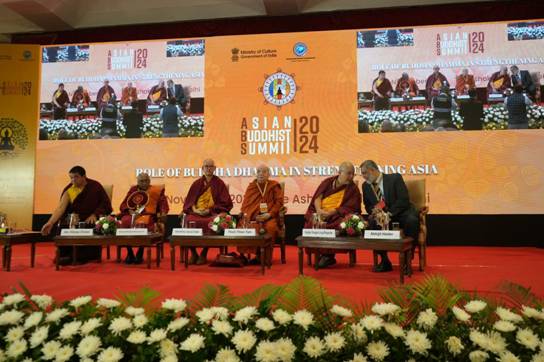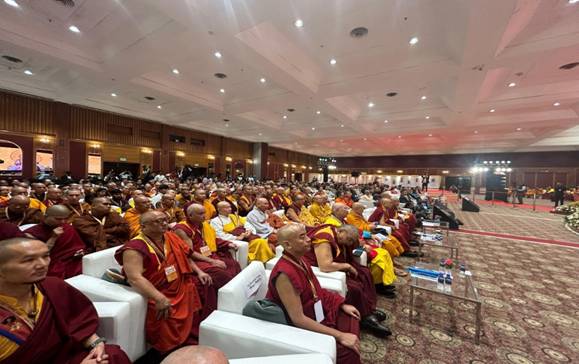Ministry of Culture and International Buddhist Confederation organized First Asian Buddhist Summit on 5th -6th November 2024 in New Delhi
Ministry of Culture and International Buddhist Confederation organized First Asian Buddhist Summit on 5th -6th November 2024 in New Delhi
Ministry of Culture and International Buddhist Confederation organized First Asian Buddhist Summit on 5th -6th November 2024 in New Delhi. One of the remarkable achievements of the first Asian Buddhist Summit was the successful organization of the two parallel forums, each offering an array of insightful perspectives. The arrangements of these forums allowed for a rich convergence of ideas, with one focusing on the foundational teachings of the Buddha and their modern-day applications, while the other explored the ways in which Buddhist principles can contribute to sustainable development, social harmony, and international cooperation.

There were several presentations that offered unique alternatives, perspectives, and some ‘out of the box’ approaches looking at philosophical knowledge as a means for application and practical usage for the betterment of society. Seminars and Conferences, hitherto, had been mainly concerned with the religious aspects and its associated discourse. This Summit threw up many innovative ideas emanating from the ancient philosophy and science of Dhamma.

The First Asian Buddhist Summit, was organized by the Ministry of Culture and the International Buddhist Confederation (IBC), themed ‘Role of Buddha Dhamma in strengthening Asia’ . It saw a participation from 32 countries with over 160 international participants. Members of the Mahasangha, patriarchs of various monastic traditions, monks, nuns, members of the diplomatic community, professors of Buddhist studies, experts and scholars, around 700 participants, engaged enthusiastically with the topic.
Prof. Ceon Ramon from the Dept. of Electrical and Computer Engineering University of Washington, USA drew a comparison between the duration of Mental Cognition from Neuroscience and the Buddhist Perspectives of meditation in their Clinical Applications. Reflecting on the nature of arousal and cessation of a thought (the Dhyan- moment), measurements showed that these time frames are what meditators inferred centuries ago without a clock. This can be useful in the treatment of mental disorders based on Buddhist practices of paramitas and meditation combined with neurofeedback and visualization techniques.
A unique contribution of Buddhist practice was introduced in Mongolian prisons by MrShirendevDorlig, Director of the Vipassana Research Center in Mongolia. After some initial hiccups Vipassana meditation courses are giving very good results even in prisons with hardened criminals.
In his presentation MrDorlig stated that he insisted on certain working conditions from the prison authorities before initiating the courses. This included training of the prison officials in vipassana practice, a strictly regimented menu that was in line with the practice and tradition, and a daily ‘group sittings’ for the inmates at the end of the day to get a realistic assessment of the success rate.
Many presentations highlighted the vast areas in Central Asia, East Turkestan and the Russian Autonomous Republics of Kalmykia, Buryatia and Tuva that Buddhism had impacted, such as its influence in architecture, worshiping practices and the philosophical way of life, traces of which were evident archaeologically as well in ancient texts still available.
Dr. Jagbir Singh from the Department of History, Dyal Singh Evening College, University of Delhi spoke about the Buddhist Influences on the Evolution of Chinese Architecture. He traced its development from the Han Dynasty to the present day.
In the 1st century the Han emperor Ming constructed the white horse monastery in honour of the first two Indian monks who went from India to China – KashyapMatanga and Dharmaratna.
This was the birth of Chinese Buddhist architecture. This form of architecture subsequently was woven into pure Chinese architecture resulting in a unique architectural heritage that reflects the spiritual and aesthetic values of Buddhism.
Prof. Dr. Shobha Rani Dash, Head of the Department of Buddhist Studies, Otani University, Kyoto, Japan mentioned about the Hindu deities worshipped in Japanese Buddhism. She explained the pantheon of Hindu deities who were introduced to Japan with Buddhism as the Devas of the Buddhist pantheon. But gradually many of them have been assimilated with the Japanese native cult of Shintoism as well. She made a special mention of goddess Saraswati who is known as Benzaiten in Japan and revered by the locals.
Dr. YalcinKayali, Associate Prof. of Eastern Languages and Literatures at Ankara University, Turkey brought out the less known fact about the presence of Buddhism in the Uighur Turkish cultural world. This study focused on the Buddhist text known in Sanskrit as the SuvarṇabhāsaSūtra, which was transferred from the Chinese translation of the Dharmakshema to the Uyghur-Turkish Buddhist heritage area and named AltunYaruq (Golden Light Sūtra).
Dating back to the 4th century, its Chinese translations and those into Japanese and other European languages are thought to have contributed to incorporating ancient Buddhist doctrine into the world’s cultural heritage.
Similarly, Dr. Baatr U. Kitinov, Research Fellow from the Institute of Oriental Studies, Russian Academy mentioned how Buddhism had spread to eastern Turkestan and the role of the Uyghurs in sustaining Buddhism for long periods. He mentioned that Buddhism is still being practiced by certain smaller population groups in east Turkestan, who are expanding in number.
Ven. Dr. PolgolleKusaladhamma, HoD, Pali and Buddhist Studies, SIBA Campus from Sri Lanka explained the role of neurological researches on Buddhist meditation to identify utility of mindfulness practices to overcome physical infirmity, and other sufferings, especially negative forces in emotions that create mental unrest, unhappiness, fear, and frustration etc.
He explained in detail on how Buddhism studies the nature of the mind and examines the rational description of the mind, guiding the followers to develop wholesome mental behaviours healing the mental afflictions.
Ven. Dr. UgyenTshering, lecturer at the International Buddhist Studies College (IBSC) of Mahachulalongkornrajavidyalaya University in Bhutan spoke about the famous concept Gross National Happiness (GNH) and how the Buddhist philosophy and principles underpin the concept of GNH, influencing Bhutan’s policies and societal values. It was Buddhism that played a significant role in enabling Bhutan to attain a high degree of GNH and explained how others can emulate the model.
Ven. Nguyen Ngoc Anh, a Vietnamese Ph.D Scholar in the University of Colombo, Sri Lanka explained the challenges that Buddhism faced in Vietnam during different periods, such as feudalism, colonialism and modernization.
However, engaged Buddhism had a profound impact on Vietnamese society; as the philosophy of liberation (Moksha), peace and happiness (nirvana) have held Vietnamese society strongly together as the country went through several conflicts. Introduced in Vietnam in the 2nd century AD, Buddhism forms the core essence of Vietnamese society.
Mr. RuslanKazkenov from Kazakhstan mentioned that even though Kazakhstan was not a Buddhist country there was a strong fondness for Buddhism and Buddhist philosophy in the country especially since Buddhism has several similarities or commonalities with Tengrianism. Moreover, Buddhism has influenced art, architecture and cultural traditions of the region (Central Asia), including elements of Buddhist art and in historical monuments. He suggested hosting the next Asian Buddhist Summit in Kazakhstan.
In the same spirit, scholars from Tajikistan and Uzbekistan mentioned how the people of these countries were becoming increasingly aware of their Buddhist heritage which was so well accepted by the locals in the early years of its spread in the region. They emphasized that there was significant scope for excavation of Buddhist sites that yet remain unexplored in these two countries. The representatives expressed keenness in engaging Indian experts on excavation and also academicians who could help stringing the essence of Buddha’s teachings and their application in this part of the world.
*****